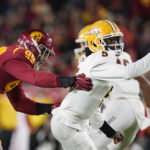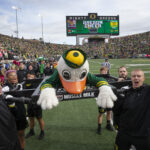The Hotline mailbag is published every week. Send questions to pac12hotline@bayareanewsgroup.com and include ‘mailbag’ in the subject line or hit me on Twitter: @WilnerHotline.
Some questions have been edited for clarity and brevity.
What is your take on all of the Pac-12 media rights “reporting” out there, including from supposedly reputable outlets and reporters? — @Cargoman0363
The Hotline has not commented on specific reporters or reports since this saga began and has no plans to start now.
If an outlet breaks news that we believe is accurate and relevant to the Pac-12, we’ll make sure fans are aware of the development.
Yes, there has been a huge amount of erroneous information published over the past 10 months — much of it fueled by social media and some of it courtesy of fans portraying themselves as “insiders” or operators of regional or local websites.
But any suggestion that ESPN is no longer interested in the Pac-12’s premium football inventory would not be accurate.
(When it comes to realignment, everybody’s an expert. Everybody has a source.)
In other instances, respected media outlets have published information that we knew to be inaccurate or lacking crucial context.
For example, the barrage of reports about the Big Ten preparing to add more schools back in the fall — that was all fueled by former commissioner Kevin Warren and the folks handling his messaging. In reality, the Big Ten presidents and media partners were never on the verge of another West Coast raid.
Keep in mind that realignment is the most difficult topic in college sports for the media to cover, for two reasons:
— Most media members have limited experience with, and poor sourcing within the areas that drive realignment strategy, especially media rights. It’s not the same as covering a coaching search or a recruiting issue.
Because the Pac-12 created its own media company, and because that company (the Pac-12 Networks) went sideways quickly, the Hotline has covered media matters for more than a decade and developed sources within that space.
We have leaned heavily on those sources over the past 10 months — to a much greater degree than we have relied on sources within the Pac-12 itself — and believe that has resulted in a fair and reasonable assessment of a complicated, highly fluid issue.
— The realignment decision-makers are university presidents whose perspectives and processes aren’t the same as those of coaches and athletic directors. And because the crucial conversations take place at the presidential level, accurate information is scarce.
Realignment is like another language. If you haven’t been properly exposed, it’s difficult to differentiate smoke from fire. To understand who knows what. To identify where agendas lie. To see how all the pieces fit together.
We want to believe everyone is doing his or her best to report fair and accurate information even if, occasionally, the reality appears quite different.
Is ESPN “out” on negotiations for the Pac-12’s Tier 1 media rights? — @LayneAbbott12
I don’t know what role ESPN will fill in the Pac-12’s media contract. That will be determined by the ebb and flow of negotiations — that’s what negotiations are all about, after all.
But any suggestion that ESPN is no longer interested in the Pac-12’s premium football inventory would be accurate.
Trust me on this: If the Hotline had substantive reason to believe ESPN was “out,” we would have reported it.
The Big 12 media and fan obsession with the Pac-12 is fascinating and has gone way beyond the point of casual interest. What do attribute this to? — @UnusualHeat
Nothing drives interest like realignment, and this situation is unprecedented because of the interlocked nature of the two conferences.
But I don’t blame Big 12 fans one bit:
— Their conference has been rocked and roiled for decades, largely because of Texas’ outsized ego and weight. Now that there is long-sought stability (courtesy of the media deal signed last fall), the fans are basking in it — and good for them.
— Also, there’s some schadenfreude at play after the Pac-12 declined to add Big 12 schools in the summer of 2021.
— Finally, Big 12 commissioner Brett Yormark’s very public strategy of trying to add the Four Corners schools has created an integrated present. It’s only natural for Big 12 fans to take an interest in schools they believe could be part of their league in the future.
When do you think the latest possible date is for the Pac-12 to finalize a media deal? — @Charlz_DeMar
That depends on the specific aspect of a complicated process.
Technically, the Pac-12 could go into the fall or winter without a deal; the media companies don’t need much time to prepare for a new contract cycle and make the necessary production arrangements.
If the Pac-12 plans to expand, then June 30 is probably a relevant date. Many conferences have steeper penalties in place for schools that give notice within 12 months of departure.
But in all candor, the drop-dead date for finalizing a deal is one minute before a Pac-12 president plans to sign a grant-of-rights agreement with another conference.
As long as the presidents remain patient, the process could go on … and on.
Is a full merger between the Big 12 and Pac-12 still an option? What is standing in the way of that? — @Marcelo_M0908
We see no scenario in which the conferences would merge in the present. The Big 12 signed a media contract and has no motivation. It’s trying to kill off the Pac-12, not join forces.
But when the next media contract cycle comes to a close in the early 2030s, the conferences very well could form a partnership or outright merger.
We expect the Power Five structure to shift radically in the next eight or 10 years, with the ACC as the epicenter of a massive breakup.
Was Larry Scott the worst commissioner in sports history, college or otherwise? — @MarcSheehan006
He’s on the short list, for sure.
As if Scott didn’t do enough damage to the conference during his tenure and create the circumstances that led to USC and UCLA leaving, his decisions are plaguing the Pac-12 years after his departure.
The Comcast overpayment fiasco, for which Scott is responsible (regardless of whether he knew or didn’t know in real time), is going to cost the schools $50 million in withheld revenue.
Essentially, Scott is the grift that keeps on taking.
But ultimately, fault lies with the university president who hired and enabled Scott for years on end. Arizona State’s Michael Crow is atop that list, followed closely by UCLA’s Gene Block and Oregon State’s (retired) Ed Ray.
Why are so many presidents who play up their connections to tech companies, and even say their graduates were there for the birth of streaming, now running away from Apple TV Plus and Prime Video? — @JWMediaDC
I have no reason to think they are “running away.” The composition of the Pac-12’s media deal will likely feature both linear and streaming components.
Exactly how that breaks down, I could only guess. But we expect games across broadcast television, cable and a streaming service.
To the best of our knowledge, none of the presidents have stated a preference otherwise.
What’s your assessment of Pac-12 football officiating? With the recent defections, do you think it is time to revamp the system? — @RockDawg3
Some aspects have improved over the past year or two. For example, communication with the sidelines and fans, and the time required for replay review.
But there were too many egregious calls in 2022 — even commissioner George Kliavkoff admitted as much.
The training and teaching need to improve.
The pipeline of young officials needs to be strengthened.
Consortiums with other conferences must be forged.
The program, which has been examined and tweaked frequently over the years, just lost three referees to the Big Ten this spring.
But one constant remains: David Coleman, the vice president for officiating. Without a change at the top, it’s difficult to imagine a significant, sustained upgrade of the product.
Will the L.A. schools still have a financial stake in the Pac-12 Networks after they leave? — @Pyperkub
The easiest way to view the media piece is as follows: Everything changes in the summer of 2024.
The L.A. school will depart with zero financial stake in anything related to the Pac-12.
The Pac-12 Networks’ distribution contracts with Comcast, DISH and others will expire.
And the Pac-12’s next media contract cycle will begin.
The networks could be turned into a production studio and streaming service operated by the remaining schools. Or they could be absorbed by a media partner.
However it unfolds, the arrangement won’t involve USC and UCLA.
The Pac-12 ranked last in the Power Five in the number of NFL draft picks with USC and UCLA still in the conference. How much of a problem is this for the conference going forward without Southern California? — @CarlAdamsWV
Actually, the Pac-12 and the ACC produced the same number of draft picks (2.3 per school) when the size of the conference is considered.
One reason for the low output in April is the number of returnees for September: The Pac-12 has a higher percentage of returning all-conference honorees than any other league.
Admittedly, we don’t know how the defection of the L.A. schools will impact Pac-12 recruiting over the long haul.
Some prospects might prefer an existence rooted in the Pacific Time Zone.
Others might favor the bigger stages provided by the Big Ten, travel demands be damned.
But our guess is that financial considerations (i.e., name, image and likeness opportunities) will be the prime driver for recruiting decisions, not conference affiliation.
In that regard, the Pac-12 can attempt to offset its challenges with strong NIL collectives.
*** Send suggestions, comments and tips (confidentiality guaranteed) to pac12hotline@bayareanewsgroup.com or call 408-920-5716
*** Follow me on Twitter: @WilnerHotline
*** Pac-12 Hotline is not endorsed or sponsored by the Pac-12 Conference, and the views expressed herein do not necessarily reflect the views of the Conference.
Related posts:

Arizona State quarterback Emory Jones, (AP Photo/Mark J. Terrill)
Saturday Night Five: Are USC and UCLA legit(?), reassessing the non-conference slate, quirky power ratings and the Dorrell Watch Pac-12 picks: Utah’s desperate but USC’s better, WSU wins and Arizona covers
Pac-12 picks: Utah’s desperate but USC’s better, WSU wins and Arizona covers
 Hotline mailbag: The future of the Four Corners schools, Big Ten and Big 12 change tones, Oregon as an Independent and more
Hotline mailbag: The future of the Four Corners schools, Big Ten and Big 12 change tones, Oregon as an Independent and more

The Oregon Duck mascot collapses after doing 38 pushups. (AP Photo/Chris Pietsch)
Pac-12 rewind: Bo Nix shines, Marshawn Lynch drops a bomb, Stanford survives, OSU rolls and loads more from Week Eight
